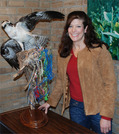
Learn about animal rehabilitators and create your own vehicle to transport a wounded animal.
- Subject:
- Ecology
- Engineering
- Zoology
- Material Type:
- Activity/Lab
- Author:
- Rachel Dellman
- Date Added:
- 01/31/2020

Learn about animal rehabilitators and create your own vehicle to transport a wounded animal.
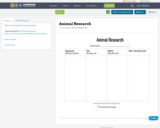
This is a notes sheet for animal research.
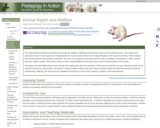
The relationship of animals and humans has been the subject of differing philosophical views for thousands of years. The controversy continues today in many aspects of contemporary life. Some people believe that a vegan lifestyle is the only moral choice. Others believe that humans should treat animals "humanely," but can use animals and animal products at will, including for biomedical or other scientific research. Others believe that humans have no moral responsibilities for animals and are free to treat animals as they want.
Advocates of animal rights believe that animals have legal rights and are members of the moral community. As such, animals should not be used by humans for any purpose. Advocates of animal welfare believe that non-human animals should be treated humanely and without unnecessary suffering, but otherwise are available for humans to use for food, clothing, research, and entertainment.
(Note: this resource was added to OER Commons as part of a batch upload of over 2,200 records. If you notice an issue with the quality of the metadata, please let us know by using the 'report' button and we will flag it for consideration.)
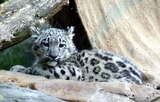
Due to a variety of ways that humans have negatively impacted the natural environment, many plant and animal species continue to become endangered and move towards extinction. Set your kindergarteners on a mission to help shelter an endangered species by creating an animal sanctuary for an animal in need. Students will create a physical model of an animal sanctuary (diorama) for an endangered animal while studying what that animal needs from its habitat in order to survive and thrive. Students will also study the ways that humans can create problems or help solve problems in the world around them This unit focuses on the NGSS Performance Expectations Bundle for Kindergarten Life Science (K-LS1-1, K-ESS2-2, K-ESS3-1, K-ESS3-3).
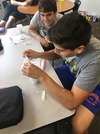
In this lesson, students will discover how to administer three different types of injections (Subcutaneous, Intramuscular, and Intravenous) though a hand-on activity. Students will use actual syringes and needles to administer medication to their animal (hamburger buns in a sandwich bag). Along with the injection lab students will learn the difference between medications and vaccinations, and why they are both important!

Students listen to fiction and nonfiction read-alouds and explore selected Websites to identify factual information about animals. This lesson focuses on ants, but can be adapted to any animal.
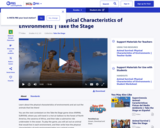
Learn about the physical characteristics of environments and act out the animals that live there!
You are the next contestant on the Take the Stage game show ANIMAL SURVIVAL where you will travel in a hot air balloon to the forest of North America, the savanna of Africa, and then take a submarine ride underwater in the ocean. To play the game, you will act out an animal that would live in each environment, and then write how the physical characteristics of each environment helps your animal survive.
Learning Objective: observe and describe the physical characteristics of environments and how they support populations and communities of plants and animals within an ecosystem.
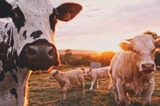
The uses of animals in biotechnology are expansive, and many times overlooked. This lesson will have students exploring the wide range of uses of animals in biotechnology and formulating an opinion about the uses of animals in biotechnology.

Students build a 9 M X 9 M model of an animal or plant cell with cell organelles inside it and give cell tours to Life Science students. May be done as two large groups, or a whole class project.
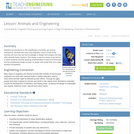
Students are introduced to the classification of animals and animal interactions. Students also learn why engineers need to know about animals and how they use that knowledge to design technologies that help other animals and/or humans. This lesson is part of a series of six lessons in which students use their growing understanding of various environments and the engineering design process, to design and create their own model biodome ecosystems.

I want to teach the kids on different animals and their habitats. But first, I want to start the lesson with the hatching of eggs. Show them what this world has to offer. Then tell them about how humans are treating the earth and how can we fix it in different environments. But first, they need to know the different environments and the animals inside them so they know how to help. They will be assigned a presentation on different animals in the habitats, and at the end, I will be giving a quiz on it.
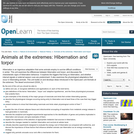
Hibernation is an ingenious adaptation that some animals employ to survive difficult conditions in winter. This unit examines the differences between hibernation and torpor, and discusses the characteristic signs of hibernation behavior It explores the triggers that bring on hibernation, and whether internal signals or external season cues are predominant. It also examines the physiological adaptations that occur in hibernating animals.

The extreme challenges of life in the polar regions require the animals who make their habitat there to make many adaptations. This unit explores the polar climate and how animals like reindeer, polar bears, penguins, sea life and even humans manage to survive there. It looks at the adaptations to physiological proceses, the environmental effects on diet, activity and fecundity, and contrasts the strategies of aquatic and land-based animals in surviving in this extreme habitat. This unit builds on and develops ideas from two other 'Animals at the extreme' units: The desert environment (S324_1) and Hibernation and torpor (S324_2).
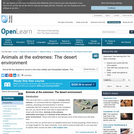
Animal life has adapted to survive in the most unlikely and inhospitable habitats. This unit looks at the surprisingly diverse desert climates throughout the world and mammals, birds, lizards and amphibians that survive there. It splits these animals into three groups according to their strategy for survival: evaders, evaporators and endurers, then discusses how these strategies work on a biochemical and physiological level.
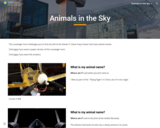
This digital scavenger hunt challenges you to find aircraft at the Steven F. Udvar-Hazy Center that have animal names.

This paper version of our popular scavenger hunt challenges you to find aircraft at the Steven F. Udvar-Hazy Center that have animal names.

In this lesson plan, students will learn about the 12 animals of the Chinese zodiac. In the introductory first lesson, they will see how animals are often used as symbols. In the second lesson, they will hear one of several versions of how the 12 animals were chosen. They will then focus upon a few of the animals in the story and see how they can be used as symbols of certain human characteristics. In the third lesson, they will be introduced to the other animals of the zodiac, and they will be given a chart on which they will assign traits to each animal. Then they will consult a number of websites to find the traits traditionally associated with the animals, which they will add to their list. Then, they will come up with a number of ways to compare and contrast the animals in the list. In the third lesson, they will focus upon the animal associated with the year of their birth, learning about its traits and discussing whether or not these apply to themselves and their peers. Finally, each student will make an acrostic, combining the letters of his or her first name with adjectives that relate to his or her zodiac sign.
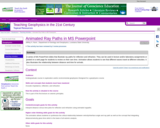
Students are shown a series of animations in powerpoint. Each powerpoint slide illustrates a basic concept in reflection and refraction (e.g., Snell's law, Crossover distance, Crossover time, dipping layers, multiple interfaces. As the slides are animated, students see the distance versus time relationships. These slides can be given to students so that they can review the concepts as many times as is necessary. Addresses student misconceptions
(Note: this resource was added to OER Commons as part of a batch upload of over 2,200 records. If you notice an issue with the quality of the metadata, please let us know by using the 'report' button and we will flag it for consideration.)

Following the traditional form of the haiku, students publish their own haikus using Animoto, an online web tool that creates slideshows that blend text and music.
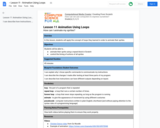
In this lesson, students will apply the concept of loops they learned in order to animate their sprites.